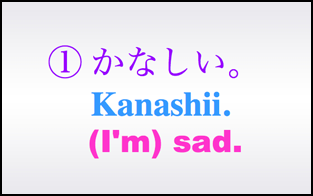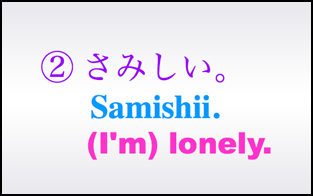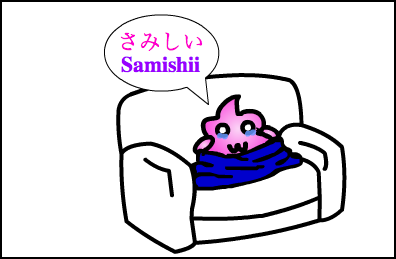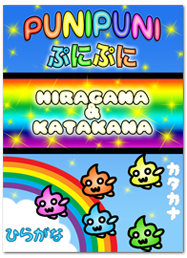☆ PuniPuni Youtube ☆
Japanese Phrase Lesson 10: Sad & Lonely – Review Notes
Today we learned two Japanese words to express sadness. We learned the Japanese word for “sad” (kanashii) and “lonely” (samishii). In this review we will learn the negative and past tense of these words.
………………………………………………………………………………..
Number 1:

★ Sad in Japanese is Kanashii.
★ When used by itself in a sentence, it means “I’m sad.”

★ If you want to say you were sad, you can say “kanashikatta.”
★ You can add “desu” at the end to make it more formal.
………………………………………………………………………………..
Example 1:
悲しいです。
kanashii desu.
I am sad.
………………………………………………………………………………..
Example 2:
ペットが死んで、悲しかったです。
Petto ga shinde, kanashikatta desu.
I was sad because my pet died.
………………………………………………………………………………..
Number 2:

★ Lonely in Japanese is Samishii. Sometimes people spell/pronounce it with a “b” instead of an “m” making it sabishii. Either one will work in every form.
★ When used by itself in a sentence, it means “I’m lonely.”
★ If you want to say you were lonely, you can say samishikatta or sabishikatta.

………………………………………………………………………………..
Example 1:
彼がいなくてさみしい。
Kare ga inakute samishii.
I’m lonely when he’s not here.
………………………………………………………………………………..
Example 2:
子供のころは友達がいなくてさびしかった。
kodomo no koro wa tomodachi ga inakute sabishikatta.
I didn’t have friends when I was a kid so I was lonely.
………………………………………………………………………………..
Other forms:
sabishikunai/samishikunai – not lonely
sabishikunakatta/samishikunakatta – was not lonely
………………………………………………………………………………..
Conclusion:
In this lesson we learned how to say lonely (samishii/sabishii) and sad (kanashii) in Japanese. Hopefully you don’t have to use these phrases very much in real life! If you feel samishii or kanashii, tell us in the comments below and we will give you some love! ♡
………………………………………………………………………………..
Clannad was such a kanashii anime…..(/□\*)・゜゜

………………………………………………………………………………..
………………………………………………………………………………..
………………………………………………………………………………..
Do you want a Japanese tutor?
Take Japanese Skype Lessons with Professional Japanese Teachers on kakehashijapan.com!















8 comments
You can just say かなしくないです。(I am not sad/I will not be sad) or さびしくないです。(I am not lonely/I will not be lonely) \(◕ω◕)/♪
Comment by PuniPuni on 05/26/2013 at 8:23 pmCan you explain inakute to me? I know it has to do with iru and maybe the negative form inai, but why is it -kute and not just -te?
Comment by Ashley on 07/31/2013 at 12:42 pmYou are right! inakute is the -te form of the negative form (-nai form) of the verb iru. This rule applies to other negative verbs as well. For example, the negative form of the verb suru is shinai, and the -te form of shinai is shinakute. So, to make the -te form out of a negative verb, just take the i off the end of the negative verb and add -kute! (◕ω◕)♪
Comment by PuniPuni on 08/01/2013 at 5:04 pmI want to learn more japanese language,where will i learn?
Comment by Sangsangi on 10/09/2013 at 3:52 pmWe have many video lessons on our website, but if you want to learn more Japanese I recommend you join our online school at http://kakehashijapan.com
If you join, you can talk with Japanese tutors through Skype. You can learn Japanese grammar, conversation, and anything else you want with our real live teachers from Japan! \(◕ω◕)/♥
Comment by PuniPuni on 10/10/2013 at 8:10 amWhat’s the point of the -nakute verbs? I don’t know when to use them. Do you have some tips? I loveeee your website by the way! 🙂
Comment by 眼鏡 on 05/02/2014 at 12:44 pm-nakute verbs are actually just the -te form of a negative verb. You can make the te-form of a negative verb the same way that you make the te-form of an i-adjective. Just take off “i” and add “kute.” (details in lesson below)
How to make the te-form of adjectives: http://www.punipunijapan.com/te-form-adjectives/
There can be many reasons that you would want to make the te-form of a negative verb. We will be making more videos on this subject soon, but for now you can learn more about the te-form of verbs here:
http://www.punipunijapan.com/te-form-making-requests/
http://www.punipunijapan.com/te-form-and/
I hope that helps! (>ω<)♥
Comment by PuniPuni on 05/07/2014 at 6:07 amHow was it that when I read what this lesson was about, I knew Clannad would be at the bottom of the review?
Comment by bobmonkeys on 06/08/2014 at 5:12 am